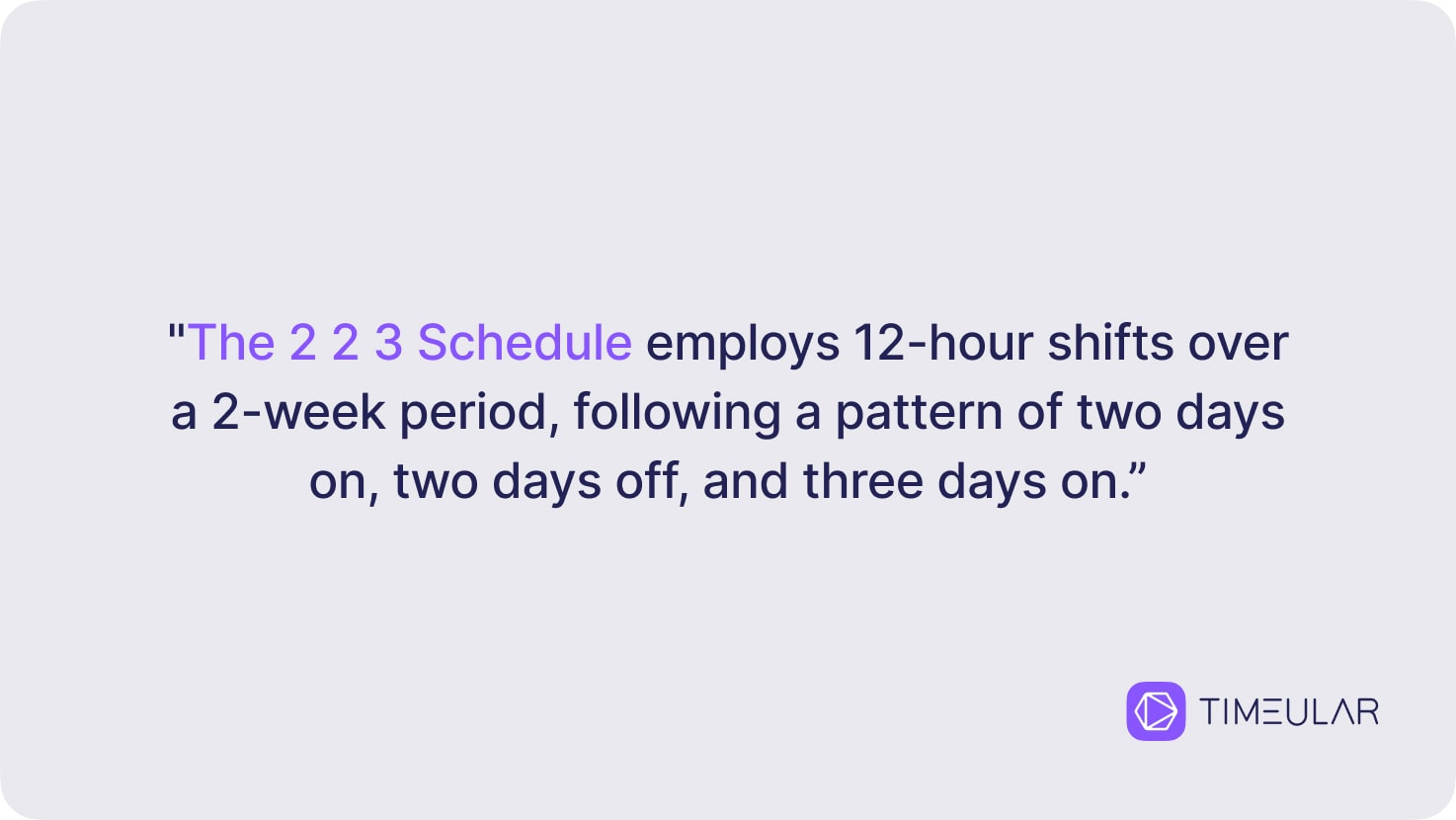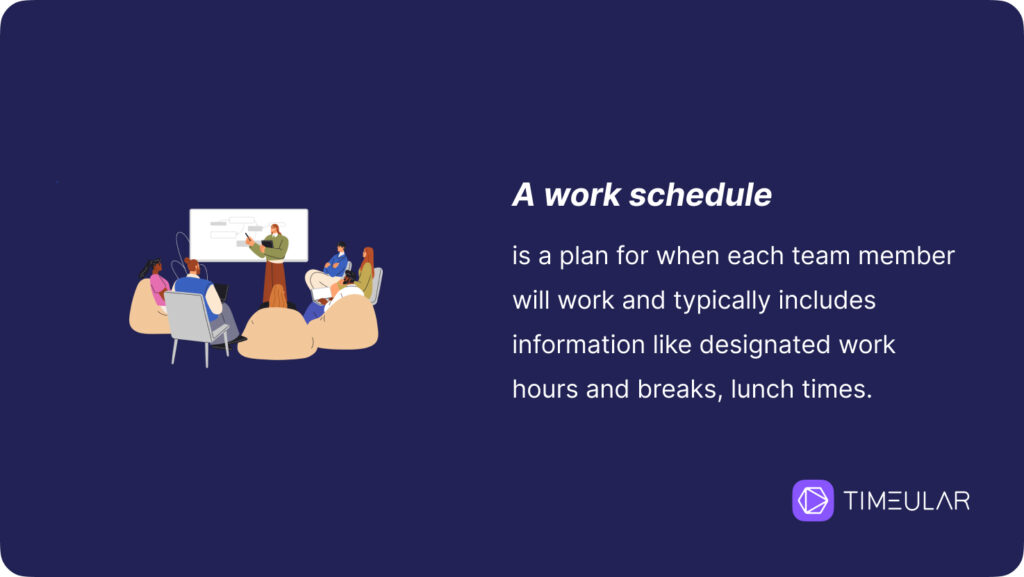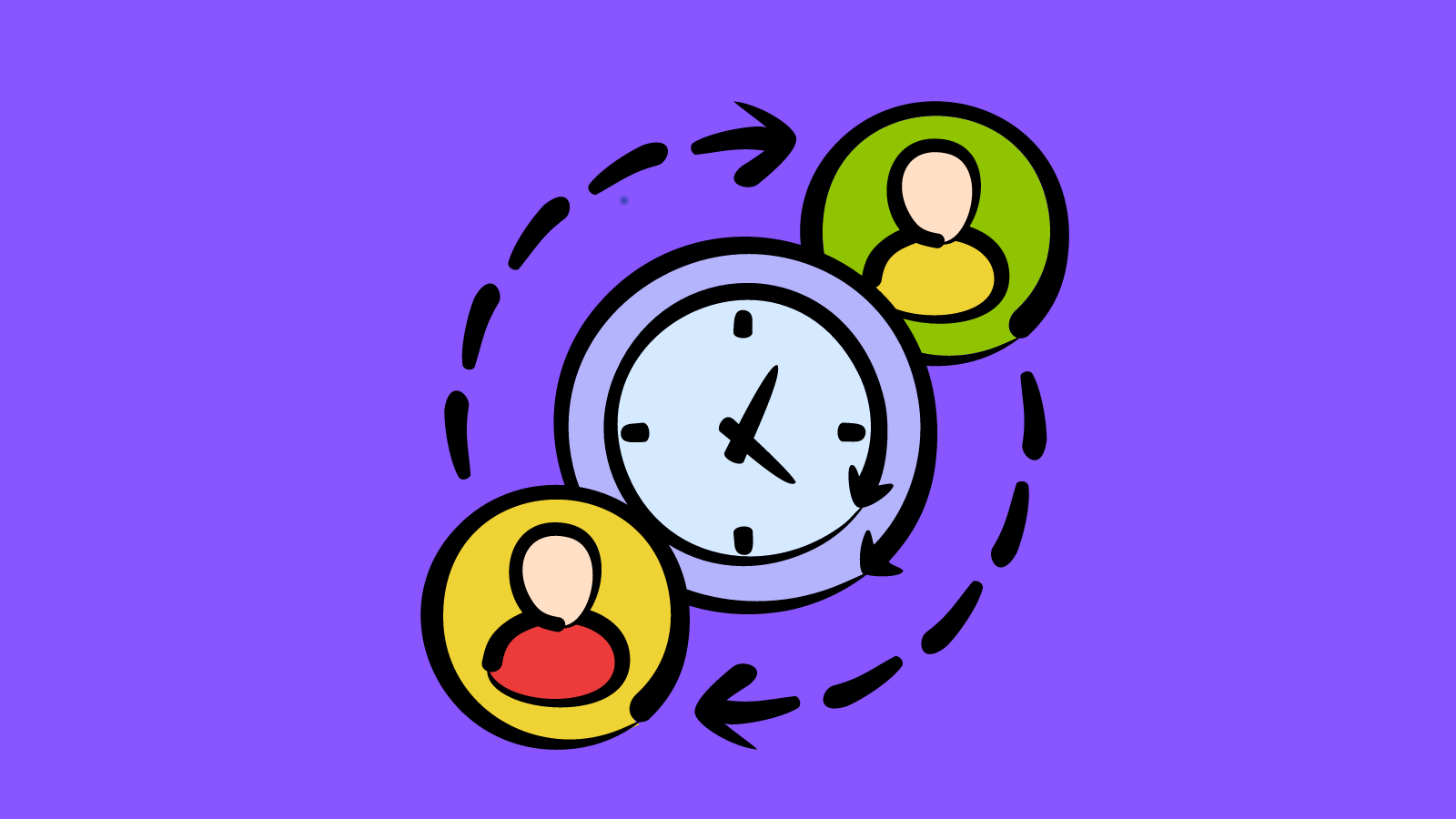The 2 2 3 Schedule: Pros, Cons, and Alternatives
Are you finding it challenging to maintain 24/7 coverage while keeping your team energized and motivated?
The 2-2-3 schedule might be the solution you need. Known for its balanced approach to continuous operations, this shift scheduling pattern is designed to keep your business running smoothly without compromising employee well-being.
In this guide, I’ll introduce you to this rotating shift schedule with day and night shifts, walking you through its advantages, challenges, and variations of the same schedule.

What is the 2-2-3 work schedule?
The 2-2-3 work schedule is a rotating shift pattern designed to provide coverage around the clock with a simple and predictable cycle. For such a work schedule, you’ll need four teams who split their work into day and night shifts. In essence, employees work 12-hour shifts over a 2-week period, following a pattern of two days on, two days off, and three days on.
The 2 2 3 work schedule then reverses, with the employee working two days on, two days off, and two days on, followed by three days off. Often used in industries that require 24/7 operations, the 2 2 3 work schedule (also called the Panama schedule) is best applied in manufacturing, healthcare, call centers, and public safety.
- Recommended read: Business productivity reinvented: Unconventional ways to stay ahead of your competition.
How does the 2-2-3 work schedule work?
To better understand how the Panama schedule functions, let’s break it down:
Week 1:
Day 1 & 2: Work
Day 3 & 4: Off
Day 5, 6, & 7: Work
Week 2:
Day 8 & 9: Off
Day 10 & 11: Work
Day 12 & 13: Off
Day 14: Work
This cycle then repeats, providing employees with every other weekend off. Over the course of a two-week period, employees work a total of 7 shifts, equating to 84 hours.
Exemplified in a four-week cycle, here is how the 2 2 3 shift work schedule would look like:
| Week | Mon. | Tue. | Wed. | Thu. | Fri. | Sat. | Sun. |
|---|---|---|---|---|---|---|---|
| 1 | Team A🔆 | Team A🔆 | Team A🛌 | Team A🛌 | Team A🔆 | Team A🔆 | Team A🔆 |
| 2 | Team B🌙 | Team B🌙 | Team B🛌 | Team B🛌 | Team B🌙 | Team B🌙 | Team B🌙 |
| 3 | Team A🛌 | Team A🛌 | Team A🔆 | Team A🔆 | Team A🛌 | Team A🛌 | Team A🔆 |
| 4 | Team B🛌 | Team B🛌 | Team B🌙 | Team B🌙 | Team B🛌 | Team B🛌 | Team B🌙 |
Table legend:
🔆 = Day shift
🌙 = Night shift
🛌 = Rest day
In this 2-2-3 shift pattern, Team A and Team B alternate between day shifts, night shifts, and rest days over a two-week cycle, which makes sure you’ll have 24/7 coverage with consistent time off. Leave time and work time schedule to ensure the good physical and mental health of your employees.

Types of 2 2 3 work schedule alternations
The DuPont schedule
The DuPont shift schedule is a more complex type of shift work method. It is, however, applicable to the same industries as the 2 2 3 work schedule works for. It involves a slow rotation cycle of 12-hour shifts, with built-in breaks and days off, alternating as well between day and night shifts equally.
The DuPont schedule requires four teams to implement your shift schedules and can look as follows:
Week 1: Four night shifts
Week 2: Three days off
Week 3: Three consecutive day shifts
Week 4: One day off
Week 5: Three consecutive night shifts
Week 6: Three days off
Week 7: Four-day shifts
Week 8: Seven consecutive days off
Remember, three-night shifts of 12 hours each might be challenging and tiring for your employees. So, consider carefully before applying such a schedule for your workforce. Your team might prefer and perform better on eight-hour shifts as it allows for more rest.
Advantages of the DuPont shift schedule:
Fewer shift handovers and less friction
Round-the-clock coverage
Long recovery time for employees for adequate rest
Disadvantages:
12 hours shifts increase health and safety risks
Difficult work schedules for certain employees

Make sure your time is well spent by tracking and managing it with automatic time-tracking apps.
2. The Pitman shift schedule
The Pitman schedule, like the DuPont schedule, includes rotating shifts to provide round-the-clock coverage for all business operations. The difference is that the Pitman schedule offers a simpler rotation pattern and is often preferred for its predictability and employee-friendly structure.
It involves 12-hour shifts, too, and operates on a 2-week cycle with alternating day and night shifts.
Here’s how a typical Pitman cycle might look:
Week 1:
Days 1 & 2: Two consecutive day shifts
Days 3 & 4: Two days off
Days 5, 6, & 7: Three consecutive day shifts
Week 2:
Days 8 & 9: Two consecutive night shifts
Days 10 & 11: Two days off
Days 12 & 13: Three consecutive night shifts
Day 14: Off
This alternating pattern continues, with employees working either day or night shifts on a fixed basis, and it makes it easier to plan personal activities around work.
Advantages of the Pitman schedule:
Consistent work-life balance with every other weekend off
Simplicity in scheduling with a 2-week rotation pattern
Continuous coverage
Disadvantages:
Long shifts (12-hour shifts)
Night shift challenges for employees
3. The DDNNOO schedule
The DDNNOO schedule involves a repeating cycle of day shifts, night shifts, and days off, as well, but with a straightforward 6-day rotation for multiple teams.
Here’s how a typical DDNNOO cycle works:
Days 1 & 2: Two consecutive day shifts (12 hours each)
Days 3 & 4: Two consecutive night shifts (12 hours each)
Days 5 & 6: Two days off
After the 6-day cycle, the pattern repeats.
Advantages of the DDNNOO schedule:
Predictability, as its implementation is closer to a fixed schedule type
Simplified management, as it is simpler than other shift patterns and reduces administrative burden for managers
Disadvantages:
Long shifts of 12 hours which can be demanding
This may include up to 32 hours of overtime work in certain weeks
Advantages of the 2-2-3 work schedule
Implementing the 2-2-3 work schedule brings numerous advantages for businesses and teams:
1. Consistent coverage
Ensuring round-the-clock coverage is pivotal for businesses that operate 24/7. The 2-2-3 work schedule promotes seamless handovers between shifts, with lower downtime periods. This is particularly beneficial in industries like healthcare, where patient care cannot be compromised, or in manufacturing, where machinery must be monitored at all times.
2. Simplified scheduling for businesses
Using a straightforward shift schedule like the Panama schedule makes it easy for managers to plan shifts. Its simple repeating pattern is easy to understand and implement. Hence, it reduces the back-and-forths associated with more complex scheduling systems.
3. Lower costs
If you’re looking to minimize overtime expenses, the 2-2-3 work schedule can bring these unexpected advantages, too. As it evenly distributes shifts across two weeks, the Panama shift scheduling reduces the likelihood of employees exceeding regular working hours. The unexpected result is that it reduces overtime hours and pay while contributing to employee well-being.
2. Improved work-life balance
One of the significant advantages the Panama Schedule brings to employees is the predictability and the ability to plan their personal duties more effectively. The predictable rotation and regular days off, including every other weekend, help employees have a better work-life balance.
3. Increased productivity
Employees who work on shift schedules often report higher productivity levels. Longer shifts give them the chance to focus more over certain time periods. At the same time, the regular breaks help them recharge and return to work refreshed. This structure can lead to better overall performance and higher-quality output.
Challenges of the 2-2-3 work schedule
While the 2-2-3 schedule offers many benefits, it’s not without challenges. Here are some common issues you may face upon deployment and strategies for overcoming them:
1. Employee fatigue
Working 12-hour shifts inevitably leads to fatigue. To mitigate this, encourage employees to take regular breaks during their shifts and promote a healthy work-life balance. Ensure that your team has access to ergonomic workstations, healthy snacks, and hydration stations.
2. Scheduling conflicts
Despite the predictability of the 2-2-3 work schedule, conflicts can still arise due to personal commitments or emergencies. To address this, consider implementing a shift-swapping system that allows your team to trade shifts with colleagues. Of course, you decide on your own rules for management to approve the swap.
4. Adaptability to industry changes and needs
As your business grows, the demands on your workforce change, too. It’s essential to remain flexible and adapt the 2 2 3 work schedule as needed. Regularly review your scheduling practices and be open to experimenting with different patterns if your current schedule no longer meets your business’s or team’s needs.
Technology in managing the 2-2-3 work schedule
Your rotating shift schedule process needs to be automated if you’re looking to make it successful and streamline its implementation and management. Hence, incorporating technology is essential. Here’s how technology can support your scheduling efforts:
Time tracking
Time-tracking tools help ensure that employees work on their scheduled shifts and take the necessary breaks. Moreover, an automated time-tracking app surfaces if your team works overtime or has deficit hours, and you can evaluate if any changes are needed to the schedule itself.

Make sure you plan the work schedule based on data. An automatic time-tracking surfaces your time spending habits, as well as where productivity is sinking.
Implement your 2 2 3 work schedule
You should be equipped with all information needed to start implementing your 2 2 3 work schedule. Remember, before starting to implement or even create a new work schedule, take into account your team’s opinions and needs. With the right strategies in place and the right work schedule for your unique case, you can balance your business demands with a happy team.
Keep in mind these steps in your 2 2 3 schedule implementation for a successful deployment:
1. Assess your business needs
Staffing requirements: Do you need 24/7 coverage, or can shifts be limited to certain hours?
Employee preferences: Are your employees open to working 12-hour shifts, or would they prefer shorter shifts with more frequency?
Operational efficiency: Will this schedule improve your overall operational efficiency, or are there better alternatives?
2. Ask your team’s opinion
3. Create a trial period
4. Develop a rotation plan
5. Communicate the schedule clearly
6. Monitor and adjust
FAQS
What other day and night shift schedules are out there?
Some other examples you could look into are the Panama Plus shift schedule, the on-call schedules, the 9-80 shift schedule, or compressed schedules like the 4-10 shift schedule.
For what industries is the 2-2-3 work schedule suitable?
The Panama shift schedule is versatile and can be applied to many businesses and industries. However, the most frequently met ones are manufacturing plants, healthcare facilities, public safety and emergency services, and hospitality and retail. Business operations requiring customer service call centers at all times are an idea, too.
Is the 2-2-3 work schedule right for my company?
The 2-2-3 work schedule suits businesses with work that can be finalized in a compressed schedule and employees who can manage longer workdays. However, it’s important to consider your company’s specific needs and your employees’ preferences before implementing the Panama schedule.